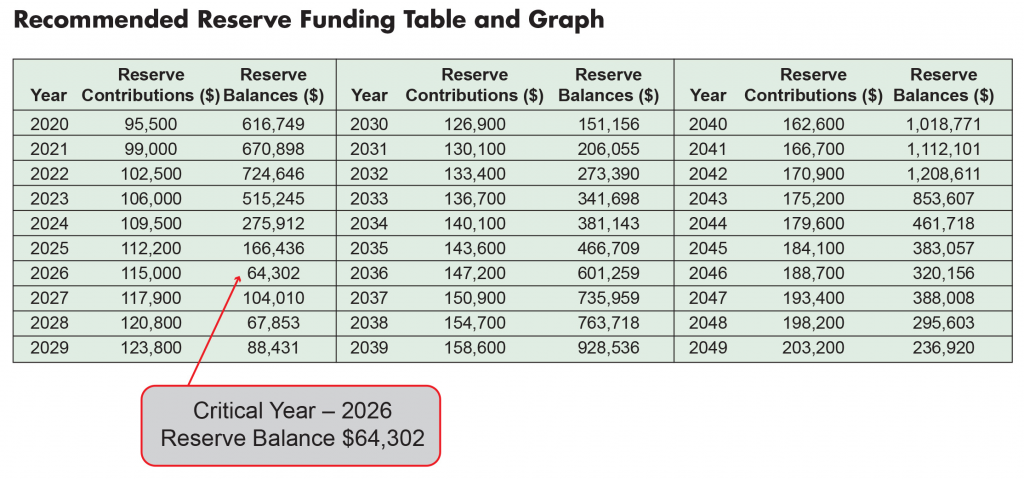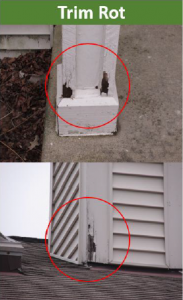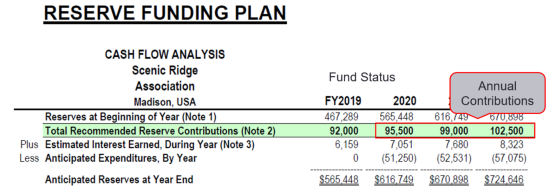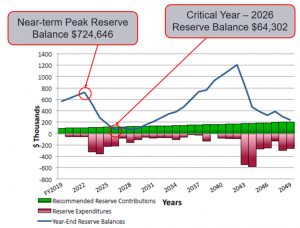It is estimated that more than 22 percent of the U.S. population resides in community associations. According to Community Associations Institute’s latest statistical review, these residents are represented by roughly 346,000 community associations (CAI 2017 statistical review). As the community association living space continues to evolve so does the way they are managed. Professional services are continually enhanced, offering association stakeholders the most effective tools to proactively manage their property for years to come.
What is a Reserve Study?
A reserve study determines how much to collect in annual reserve contributions so a Board of Directors can afford capital projects when they are needed. The reserve study is made up of two parts, as defined by Community Associations Institute (CAI) and the Association of Professional Reserve Analysts (APRA): the Physical Analysis and the Financial Analysis of common elements.
The Physical Analysis comprises three elements:
- Component Inventory (identification of the common elements and their quantities);
- Condition Assessment (evaluation of the current condition of each component based on the observation of the engineer or reported characteristics);
- Life and Valuation Estimates (the engineer’s team determines a finite useful life, the remaining useful life, or better stated, how much longer it will last before needing replacement, and the anticipated future cost of repair or replacement for each component).

The Financial Analysis has two components:
- Fund Status. That’s the current amount of money in reserves when the engineer conducts the reserve study. It will be as of a specific date, often times the beginning of the fiscal year for the association. This is the starting point for the engineer as he or she develops the funding plan.
- Funding Plan. This is the plan that assesses the unit or homeowners monies that go into the association’s reserve account to offset the anticipated future expenditures, allowing the community to pay for those capital projects as they become necessary. The funding plan goes out a minimum of 20 years into the future, and more commonly, are developed as 30-year forecasts.
What do you Receive with Your Reserve Study?
A standard reserve study comprises two deliverables; the report (including executive summary, expenditures table, funding plan and component specific narratives) and excel spreadsheets; each of which serve different purposes.
The Executive Summary, contains high level details, or better put, a 10,000 foot view of the association’s current reserve fund status and long-term funding needs. It commonly includes a table of annual contributions along with anticipated expenditures and year-end reserve balances. Furthermore, it highlights near-term major projects. Distribution of this document typically includes homeowners, realtors and prospective buyers as it communicates the association’s path to maintaining the owners’ largest investment…..their homes.

The Expenditure Table, provides a detailed component inventory with a prioritized replacement schedule including itemized costs. Having the entire component inventory and future events all in one place provides stakeholders with a complete picture of both near-and-long-term capital expenditures.
The Funding Plan, serves as the financial roadmap to offset the capital expenditures outlined in the expenditures table. The Reserve Specialist recommends annual reserve contributions that provide a path to adequately funded reserves.
 The Narratives, comprise component specific details geared towards educating stakeholders on the condition of and best practices for maintaining and replacing each element, empowering the Board of Directors to make the most informed decisions in the future (repair vs replace, implementation of maintenance practices, use of alternate materials, photographic documentation of conditions that justify professional recommendations, etc.).
The Narratives, comprise component specific details geared towards educating stakeholders on the condition of and best practices for maintaining and replacing each element, empowering the Board of Directors to make the most informed decisions in the future (repair vs replace, implementation of maintenance practices, use of alternate materials, photographic documentation of conditions that justify professional recommendations, etc.).
Excel™ Spreadsheets, is a dynamic tool that offers the ability to manage replacement schedules and related costs, as well as annual reserve contributions as they occur. Have projects been accelerated or deferred over time? Was a project completed under or over budget as a result of a variance in unit price? Excel allows stakeholders to keep replacement schedules current over time.
The reserve study report and excel spreadsheets provide the tools necessary to understand an association’s current physical and financial condition. Furthermore, it provides a roadmap to properly maintain the property through properly funded reserves, while allowing stakeholders to enhance future projected expenditures and subsequent funding needs.
Understanding a Reserve Study’s Financial Story
To comprehend current fund status and to effectively communicate the recommended funding plan, one must understand the purpose of reserve funds. As previously stated, the purpose of establishing and maintaining adequate reserve funds is to ensure an association can afford capital projects when they are needed. Furthermore, the reserve study aims to minimize the risk of additional financial assessments as the community ages. This understanding is also critical to developing a comprehensive annual budget and maintaining the physical condition of common property.
It is critical to review the reserve study’s funding plan as the recommendations for the next several years speaks to an association’s financial status.
- A properly funded association can generally expect consistent annual reserve contributions with inflationary adjustments over time.
- Overfunded associations likely experience annual reserve contributions that are relatively flat, or in extreme cases, decreased for several years.
- Underfunded associations generally experience stepped increases (i.e. $15,000 annual increases for x years, which are designed to get funding back on track) followed by inflationary adjustments thereafter. In extreme cases associations may see contributions double (or more) than that of their current budgeted amounts.

A common scenario amongst associations is assuming their funding status is “healthy” due to its high balance. For example, “we have $600,000 in the bank and minimal expenditures. As such we do not need to increase annual reserve contributions for several years”. Without a current reserve study the reserve balance is not necessarily a clear indication of overall financial health. Are critical projects being deferred? Does the association have a clear understanding of both near-and-long-term replacement needs? In the chart below, year-end reserve balances are projected to peak at $724,646 followed by more than $1,350,000 of major projects over the next six years. Ignoring inflationary increases would result in a $120,000 reserve shortage by 2028.
 The above scenario can only be properly assessed with the assistance of a current reserve study. Without one, the association does not know what truly awaits around the corner in terms of replacement projects and associated costs. Furthermore the lack of a current reserve study marginalizes one’s ability to sufficiently address potential shortfalls to ensure the association has a clearly defined path to achieve long-term success.
The above scenario can only be properly assessed with the assistance of a current reserve study. Without one, the association does not know what truly awaits around the corner in terms of replacement projects and associated costs. Furthermore the lack of a current reserve study marginalizes one’s ability to sufficiently address potential shortfalls to ensure the association has a clearly defined path to achieve long-term success.
Associations that lack long-term planning and those that do not execute on an appropriate funding strategy (one that is in line with the reserve study) will almost certainly end up short on reserve funds at some point in time. Without sufficient reserves, associations are faced with two decisions; 1) Defer replacement, some of which may be critical, or 2) Increase cash-flow to cover the cost of a particular project.
- Deferred replacement is a common choice amongst those facing a shortage of reserve funds. If the funding gap is small, the deferred project is non-critical (aesthetic items such as pool furniture, common area carpeting, etc.) and the association has a short-term plan to improve funding levels, then the deferral is likely not a critical issue. However, time and time again, many associations in this position often face significant reserve shortages during years of relatively significant expenses, often times leading to postponement of critical projects, and resulting in accelerated deterioration and potential safety concerns.
- Special assessments are very burdensome to homeowners. This option puts financial strain on residents, especially those with fixed incomes. Depending on the volume of assessments needed, it is likely that the additional assessments will span across several years.
- Bank loans do not require immediate contributions from homeowners. However, they have the added expense of interest. Homeowners certainly have more time to assess and adjust their personal finances unlike that of special assessments, but that convenience comes at a cost.
The above options simply address near-term funding shortages. However, these ‘band-aid’ type fixes only address the symptoms of insufficient reserves, not the real problem…..a lack of establishing adequate reserves moving forward. A reserve study is an essential tool to guide the Board of Directors has a clearly defined path to establishing adequate reserve funds well into the future.
Utilizing Your Reserve Study to Achieve Long-Term Success
Long-term success of a community association is measured by its ability to operate much like a successful business. The association must be fiscally responsible, able to invest in itself (maintain common elements) and improve the value of the organization as a whole. Although the reserve study is a professional recommendation, it is a snapshot in time. Over time, priorities and project needs change but one thing remains constant: the need to have adequately funded reserves.
The most successful associations utilize their reserve studies as a starting point and continually assess changing needs to attain continued and long-term success. But what does this process look like? In short it means keeping the schedule of expenditures and funding plan current and addressing any potential financial shortcomings in their infancy. What might seem challenging is actually quite simple with the right tools.
Engagement is key. Prior to budget season the reserve study should be updated. Minor adjustments can easily be handled internally via excel spreadsheets (whereas complex changes might indicate the need for an updated reserve study). Begin with updating the current year’s expenditures and reserve contributions. Next, review each deferred project and determine if it needs to be completed in the upcoming year. Update the timing of any deferred expenditures accordingly. Once this is complete the updated expenditure tables and funding plan can guide next year’s budget process. Furthermore, updated numbers enable one to evaluate changing needs over time and address potential year-end reserve shortages years in advance.
Keeping the schedule of expenditures and funding plan current provides management and the Board of Directors with the most complete picture of the association’s near-term project needs and long-term financial status. Surely most associations will, at some point in the future, find themselves deferring projects and/or not meeting their reserve studies recommended level of reserve contributions. Ultimately, their success is measured by the ability to weather such differences while adjusting the long-term funding strategy to ensure reserves are adequately funded and common property is maintained in excellent condition for decades to come.


